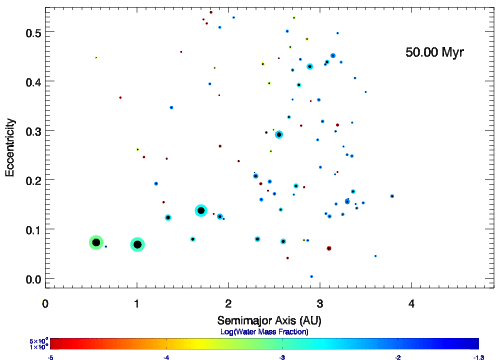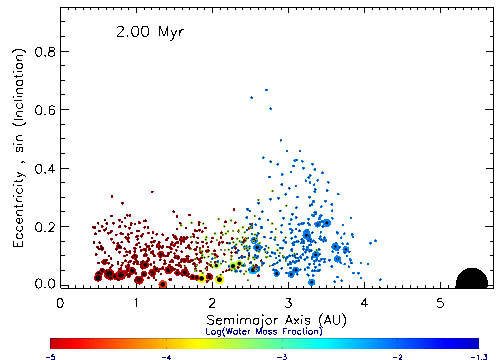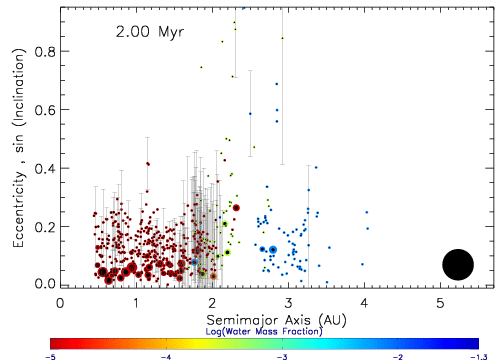Terrestrial Planet Formation and Water Delivery in the Solar System
The last phase in the growth of terrestrial planets involves the collisional accretion of a population of planetary embryos and planetesimals. In the simulations from the following movies we attempted to reproduce the inner Solar System. These attempts were, in almost all cases, unsuccessful. In particular, we were thwarted by the so-called Mars problem (Wetherill 1991): planets in Mars' vicinity were systematically too massive by a large factor (the solution is the Grand Tack). Despite this, these simulations did help to uncover many of the details of the accretion process, to demonstrate the effect of several parameters, and to show that water-rich asteroids could indeed have delivered water to the growing Earth. This first movie is a simulation from Raymond, Quinn & Lunine (2006). The simulation starts from 1885 roughly Moon-sized planetary embryos from 0.5-5 AU, and includes a fully-formed Jupiter at 5.5 AU. Note that Red = dry and blue = wet (scale is on the color bar). When the color of an object changes, it implies mixing between different radial zones. This is the basis for the asteroidal model for the origin of Earth's water (see here and here).

The following movies illustrate the effect of Jupiter and Saturn's orbits on the accretion process. In the movie on the left, Jupiter and Saturn are locked in 3:2 mean motion resonance on low-eccentricity orbits. This configuration is consistent with Jupiter and Saturn's expected behavior while they were still embedded in the gaseous protoplanetary disk, and is also consistent with their later evolution (e.g., the Nice model). However, the system produces far too many terrestrial planets (six!) including not one but two horrible Mars analogs. In the movie on the right, Jupiter and Saturn are at their current orbital separations but have much higher eccentricities (e~0.1). The dynamics of the two movies is strikingly different. The movie on the right is successful in producing a small Mars but fails because the Earth remains dry and also because such a configuration is in conflict with everything we know about the outer Solar System. These movies are from Raymond et al (2009).


The conclusion of the paper is that "standard" accretion models don't appear to be able to reproduce the Solar System's terrestrial planets. However, by considering the effect of Jupiter and Saturn's early orbital evolution we came up with an alternative model that can solve the Mars problem and reproduce the inner Solar System. That model is called the Grand Tack.
BACK TO MAIN PAGE


